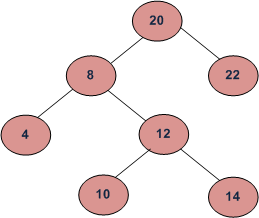Inorder Successor in Binary Search Tree
Inorder Successor in Binary Search Tree
In Binary Tree, Inorder successor of a node is the next node in Inorder traversal of the Binary Tree. Inorder Successor is NULL for the last node in Inoorder traversal.
In Binary Search Tree, Inorder Successor of an input node can also be defined as the node with the smallest key greater than the key of input node. So, it is sometimes important to find next node in sorted order.
In the above diagram, inorder successor of 8 is 10, inorder successor of 10 is 12 and inorder successor of 14 is 20.
Method 1 (Uses Parent Pointer)
In this method, we assume that every node has parent pointer.
The Algorithm is divided into two cases on the basis of right subtree of the input node being empty or not.
Input: node, root // node is the node whose Inorder successor is needed.
output: succ // succ is Inorder successor of node.
1) If right subtree of node is not NULL, then succ lies in right subtree. Do following.
Go to right subtree and return the node with minimum key value in right subtree.
2) If right sbtree of node is NULL, then succ is one of the ancestors. Do following.
Travel up using the parent pointer until you see a node which is left child of it’s parent. The parent of such a node is the succ.
Implementation
Note that the function to find InOrder Successor is highlighted (with gray background) in below code.
- C
- Java
- Python
// Java program to find minimum value node in Binary Search Tree// A binary tree nodeclass Node { int data; Node left, right, parent; Node(int d) { data = d; left = right = parent = null; }}class BinaryTree { static Node head; /* Given a binary search tree and a number, inserts a new node with the given number in the correct place in the tree. Returns the new root pointer which the caller should then use (the standard trick to avoid using reference parameters). */ Node insert(Node node, int data) { /* 1. If the tree is empty, return a new, single node */ if (node == null) { return (new Node(data)); } else { Node temp = null; /* 2. Otherwise, recur down the tree */ if (data <= node.data) { temp = insert(node.left, data); node.left = temp; temp.parent = node; } else { temp = insert(node.right, data); node.right = temp; temp.parent = node; } /* return the (unchanged) node pointer */ return node; } } Node inOrderSuccessor(Node root, Node n) { // step 1 of the above algorithm if (n.right != null) { return minValue(n.right); } // step 2 of the above algorithm Node p = n.parent; while (p != null && n == p.right) { n = p; p = p.parent; } return p; } /* Given a non-empty binary search tree, return the minimum data value found in that tree. Note that the entire tree does not need to be searched. */ Node minValue(Node node) { Node current = node; /* loop down to find the leftmost leaf */ while (current.left != null) { current = current.left; } return current; } // Driver program to test above functions public static void main(String[] args) { BinaryTree tree = new BinaryTree(); Node root = null, temp = null, suc = null, min = null; root = tree.insert(root, 20); root = tree.insert(root, 8); root = tree.insert(root, 22); root = tree.insert(root, 4); root = tree.insert(root, 12); root = tree.insert(root, 10); root = tree.insert(root, 14); temp = root.left.right.right; suc = tree.inOrderSuccessor(root, temp); if (suc != null) { System.out.println("Inorder successor of " + temp.data + " is " + suc.data); } else { System.out.println("Inorder successor does not exist"); } }}// This code has been contributed by Mayank Jaiswal |
Output of the above program:
Inorder Successor of 14 is 20
Time Complexity: O(h) where h is height of tree.
Method 2 (Search from root)
Parent pointer is NOT needed in this algorithm. The Algorithm is divided into two cases on the basis of right subtree of the input node being empty or not.
Input: node, root // node is the node whose Inorder successor is needed.
output: succ // succ is Inorder successor of node.
1) If right subtree of node is not NULL, then succ lies in right subtree. Do following.
Go to right subtree and return the node with minimum key value in right subtree.
2) If right sbtree of node is NULL, then start from root and us search like technique. Do following.
Travel down the tree, if a node’s data is greater than root’s data then go right side, otherwise go to left side.
struct node * inOrderSuccessor(struct node *root, struct node *n){ // step 1 of the above algorithm if( n->right != NULL ) return minValue(n->right); struct node *succ = NULL; // Start from root and search for successor down the tree while (root != NULL) { if (n->data < root->data) { succ = root; root = root->left; } else if (n->data > root->data) root = root->right; else break; } return succ;}
|




 浙公网安备 33010602011771号
浙公网安备 33010602011771号